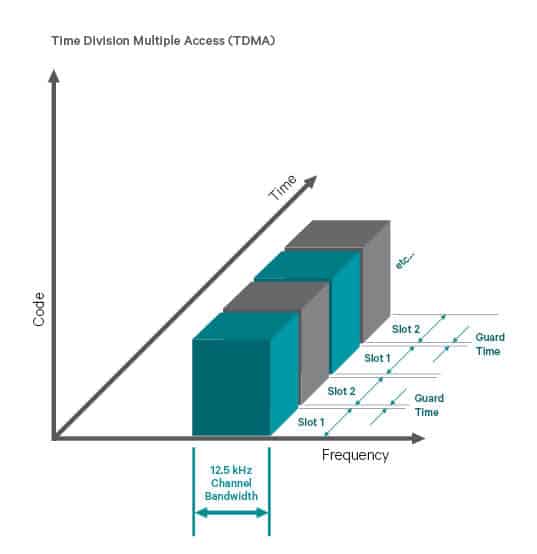 The main difference between P25 Phase 1 and Phase 2 is system capacity, so the primary reason for opting for Phase 2 is additional capacity.
The main difference between P25 Phase 1 and Phase 2 is system capacity, so the primary reason for opting for Phase 2 is additional capacity.
Phase 2 TDMA (Time Division Multiple Access) doubles the number of talk paths compared with Phase 1. P25 Phase 2 TDMA creates two logical channels in one 12.5kHz physical channel. Because the Phase 2 control channel is unchanged from Phase 1 there is compatibility between the phases.
| P25 Phase 1 vs. Phase 2: functionality comparison | |
|---|---|
| Phase 1 can be used in trunked or conventional configurations. | Phase 2 is currently available in trunking only. |
| Phase 2 requires additional coverage design considerations, especially for simulcast systems | The sites may have to be spaced closer than for Phase 1 sites. |
| Phase 1 equipment has been undergoing compliance testing sanctioned by the Federal Government Compliance Assessment Program ( CAP), sanctioned by the Department of Homeland Security. | No such program exists yet (Summer of 2013) for Phase 2. |
| Phase 2 is capable of interactive power output control and can interrupt on-going transmission from subscriber units. | No such functions in Phase 1. |
 Unless you are suffering from lack of capacity, and additional channels in your current frequency range are not available, any other arguments for choosing Phase 2 over Phase 1 are outweighed by risks and costs of Phase 2 at this time (2013). Keep in mind that most new radios will cover the entire 700/800 MHz spectrum, so these two ranges can be treated as one. This means if you cannot add more 800MHz channels, you can add 700MHz channels – most P25 radios can use both bands seamlessly.
Unless you are suffering from lack of capacity, and additional channels in your current frequency range are not available, any other arguments for choosing Phase 2 over Phase 1 are outweighed by risks and costs of Phase 2 at this time (2013). Keep in mind that most new radios will cover the entire 700/800 MHz spectrum, so these two ranges can be treated as one. This means if you cannot add more 800MHz channels, you can add 700MHz channels – most P25 radios can use both bands seamlessly.
This may of course change as the technology progresses, regulatory clarity is provided and greater competition in Phase 2 emerges.
But for the time being, you should specify Phase 1 that is upgradeable to Phase 2, and specify that the implementation and costs of such an upgrade are clearly identified in proposals.
If your system will use simulcast, keep in mind time delay interference when moving to Phase 2 in the future. Phase 2 sites may need to be spaced more closely than Phase 1.
| True or False: Common myths and misconceptions about P25 Phase 2 | ||
|---|---|---|
| Phase 2 is necessary for FCC Narrowbanding | False | although it might be required at some point in the future in the 700 MHz band. |
| Phase 2 brings added functionality to Phase 1 | False | marginal functions only |
| There are no drawbacks to using Phase 2 | False | Significant drawbacks are: coverage design considerations, lack of compliance testing, limited vendor competition |
| Everyone should upgrade to or install Phase 2 | Absolutely false! | |
| Phase 1 is an obsolete standard and being replaced by Phase 2 | False | Phase 2 augments Phase 1, to address the infrequent situations where increased traffic capacity is needed, but does not replace Phase 1. |
| Phase 2 has to use 700/800 MHz spectrum. | False | Phase 2 can be offered in any frequency band |
 This article is taken from Specifying your P25 System guide which is a part of P25 Best Practice. P25 Best Practice is a comprehensive and authoritative set of guides to P25 radio which distills P25 radio knowledge and wisdom of 30 experts with over 450 combined years of experience.
This article is taken from Specifying your P25 System guide which is a part of P25 Best Practice. P25 Best Practice is a comprehensive and authoritative set of guides to P25 radio which distills P25 radio knowledge and wisdom of 30 experts with over 450 combined years of experience.
You can download the guide, absolutely free, from the P25 Best Practice website.



